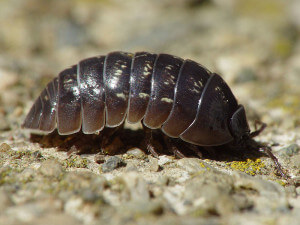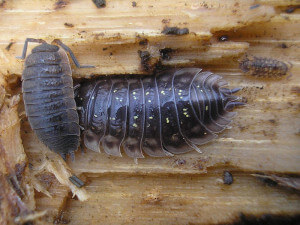
Pillbugs, also known as woodlice, roly-polies, or land shrimp are a very common arthropod in the same taxonomic class as Shrimp and lobster. These small arthropods, are very recognizable, they have 11 body segments, and can be seen curling up in a ball for defense. They can easily be found under rotting logs or bark, they love moist places with lots of rotting organic matter. Pill bugs can be found worldwide and very abundantly in the United States. All woodlice are in a taxonomic suborder called Oniscidea, therefore they could be in a number of different genus, some of the common ones are Armadillidium, Oniscus, and Porcellio.
Edibility and Culinary Use
Many people do not know that pill bugs are edible. Not only are they edible but from my experience some of them do in fact taste similar to shrimp. Any bug should be cooked before eaten, but some people eat them raw. They make a great sauce, or they can be added to soup. There are a lot of other ways to cook them including, mixed with, dough, egg, or rice.
Health Benefits

The high protein content of bugs is a known benefit. These arthropods probably contain a similar nutrient analysis to shrimp but would have to be eaten in abnormally large numbers to represent a substantial nutritional portion of anyone’s diet.
Cautions
There are thousands of species of pill bugs around the world, most of them are edible. To determine if they are edible first of all make sure it is not a pill millipede, which looks similar but is smaller, smoother and rounder. Next determine that it has no bad smell, and finally, you should not continue eating if it has a bad taste. In general the pill bug species that curl into a ball (Genus: Armadillidium) are more likely to be edible and tasty, but many of the others are as well.
Conclusion
The pill bug is one more thing to add to the list of forgotten edibles that makes me wonder, “why aren’t more people eating these”. Even in the realm of entomophagy, you don’t often hear about this one, but it is delicious and very accessible. The taboos of eating bugs in western culture are illogically strong, and this is one taboo that we would benefit to change.
Many of our readers find that subscribing to Eat The Planet is the best way to make sure they don't miss any of our valuable information about wild edibles.
See our privacy policy for more information about ads on this site







15 Responses
Entomophagy got into my head pretty much overnight some random day and now I just set up my cricket and mealworm farm.
After I saw a bunch of pillbugs in my garden, with my new open mind about edible things, I just thought completely naturally “Well… why not?”. I’ll probably breed this little guys too, so crunchy 🙂
They extract toxic metals from the soil. Mercury and such. I wonder what happens to those metals and how that might affect a human?
Not necessarily. Some research done in a Dow Chemical process water retention pond where marine shrimp were reared and that was high in heavy metals – showed no absorption by the shrimp raised in them. Three probable reasons for the result:
1. The ponds were clay lined and clay has a tight affinity for most heavy metals.
2. Heavy metals have to be in a bio-available form before they are absorbed by most organisms. Just heavy metal minerals aren’t necessarily available for absorption.
3. The shrimp were fed a commercial diet that kept would keep them from wild behavior foraging of other organisms that might uptake heavy metals.
In summary: Soil type, heavy metal forms, and providing known and controlled/standardized food ingredient sources can generally avoid heavy metal absorption from the natural environment and food contamination.
wow great. thats awesome that you set up an insect farm. I’ve wanted to do that but I’m kinda lazy and know i would not be able to keep them alive.
I haven’t tried these yet, but I will this summer.
Their shells are made out of chitin, not calcium carbonate. In fact, there is no calcium in chitin.
Thank you very much for that correction. I have since changed the article to be more accurate. I tried to look back and see where I had originally gotten that information but couldn’t find it. Thanks again.
I’d never thought to research this until now! I’ve always eaten pillbugs raw or live, as I prefer such small tidbits as they are rather than going through the trouble of boiling them or whatnot, and I can’t imagine doing it any other way! However, a young girl I take care of is frankly scared of trying insects. Of course I’d never force her, but she has asked a few times— I assume that cooking them is the best way to introduce them to her, even if I prefer them raw, correct? 🙂
I think it’s a good rule of thumb as far as safety goes to cook all insects before consumption. You’re probably right though that with certain insects the risks of eating them raw are pretty low but I’d agree with you that cooking them is a good move when introducing them to new people.
I see them the same way I look at mushrooms. Every mushroom should be cooked before consumed.
good way to look at it, I think this is true of most other insects also.
The Boys and I tried piggly wigglies (woodlice) today. We caught them and kept them 24 hours before cooking; this was supposed to make them taste better by giving them time to defecate. We had caught 13 (rolling variety) as we only needed one each to try and see what they taste like. The day after harvesting them we dropped them into boiling water and left them about one minuet before fishing them out and putting them on some kitchen towel to soak up some of the water. I bagged them up and we ate them together the next day. We found that they had very little flavor and a slight after taste. On their own they are not great but in another dish as a meat they would be fine.
Bugs are the future
Thanks a lot for posting your experience. That’s very interesting. There aren’t a lot of people that have first hand experience with this kind of stuff. I only tried one once and got a hint of a shrimpy flavor but at this point it’s hard to even remember.
These guys are great! A super source of nutrition and bugs are definitely the future. It’s better to snuff out millions and billions of little lives than one or two lives to feed my family because they are just gross bugs. I have been eating them for ten years. Well more like seven years because I switched over to a better way of consuming them. Apparently you get the same or better nutritional benefits if you just insert them rectally. The chitin really keeps my nails healthy! And I never have to worry about how they taste or keeping them for 24 hours to let them defecate. It’s even more convenient at the nudist community I visit. I have shown them how easy and convenient it is to “eat” them when on a lovely walk through the forest! I really hope eating bugs catches on! It’s the future for sure.
I did try eating various insects and discovered none is poisonous